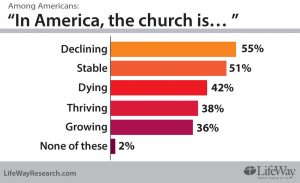 A few hours after I finished reading Greg Garrett’s new book, My Church is NOT Dying: Episcopalians in the 21st Century, I encountered a recent LifeWay Research survey that included a question about how the American church is faring. More specifically, participants were asked, “Which of the following trends do you believe describes church attendance today . . . declining, stable, dying, thriving, growing, or none of these?”
A few hours after I finished reading Greg Garrett’s new book, My Church is NOT Dying: Episcopalians in the 21st Century, I encountered a recent LifeWay Research survey that included a question about how the American church is faring. More specifically, participants were asked, “Which of the following trends do you believe describes church attendance today . . . declining, stable, dying, thriving, growing, or none of these?”
- Declining – 55%
- Stable – 51%
- Dying – 42%
- Thriving – 38%
- Growing – 36%
- None of these – 2%
So What?
Since entering vocational ministry more than 15 years ago, I have heard the word decline used far more often than any other to describe what is happening to the American church. In my own Mainline Protestant tradition the narrative of decline is now several decades old (in fact, declining membership in these traditions has been going on for longer than I have been alive!). I have contributed many blog posts to varying aspects of what is really happening, what it means, and where we might go from here.
Today, however, I am interested in the positive terms that were chosen by more than 1 in 3 survey respondents: thriving and growing. Regardless of the actual overall trends in American church life these people have position perceptions. Demographically speaking, who are these positive people? When you combine the lists for thriving and growing they share in common many tendencies, including less educated (high school degree or less), Southern (over other regions), Christian (compared to non-religious), women, and African American.
- Which words would you choose to describe church attendance today (declining, stable, dying, thriving, growing, or none of these)? Explain.
- Why do you think less educated Southerners who self-identify as Christian are among the most likely to have positive views about the well-being of the American church?